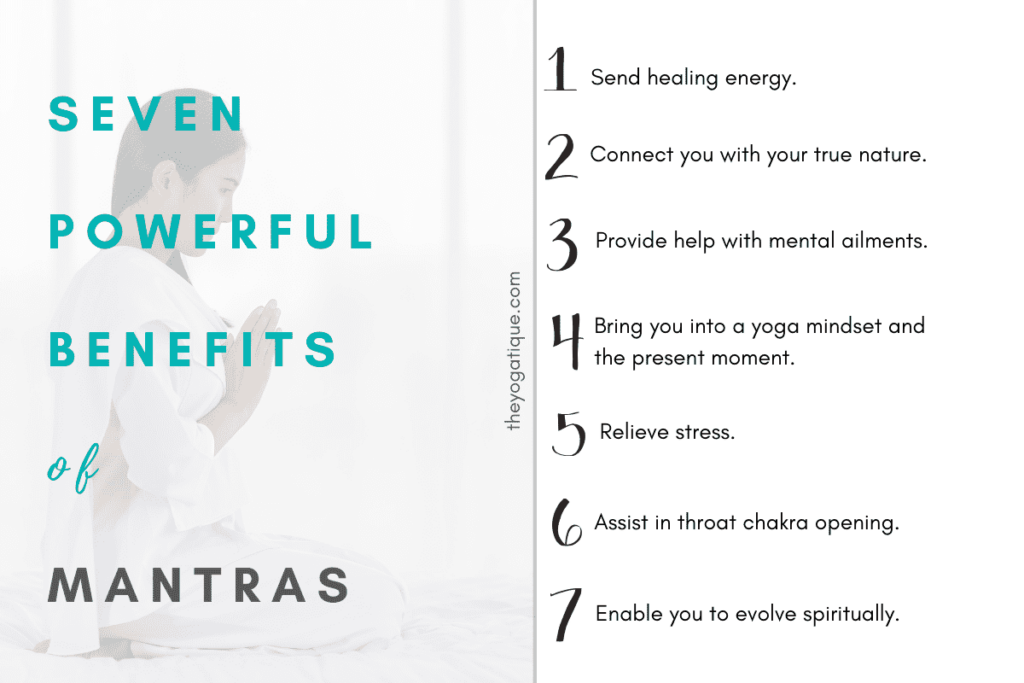
Yoga mantras are unique collections of words, where each word helps to tune the speaker's vibration to the meaning of the mantra. The word ‘mantra’ means ‘that which frees the mind from its turmoils and limitations.’
The purpose of mantras is to attract more of what you seek into your life. Mantras are concepts, ideas, and visions you absorb in the form of words. If you keep repeating and really believing in one, you will lift your state of mind to that particular vibration.
Moreover, science has proven that chanting a mantra helps to bring the brain’s left and right hemispheres into a perfect balance.
A mantra can be in the ancient language of Sanskrit or your native language. For example, there are affirmation mantras such as: “I trust my inner guidance,” “I feel I am on the right path,” and “The future is bright.”
But Sanskrit mantras are even more powerful because they are a combination of sounds that align us with the energy of the universe. They tweak and clean all there is to clean in and around you. Each sound you hear finetunes your energy to be in balance with the universal energy.
Keen to learn more? I thought so! Let’s dive in.
Article content:
(Click any link below to jump directly to section)

THE YOGA TEACHER TRAINING
YOU'VE BEEN LOOKING FOR.
Online Yoga Teacher Training Offers
- Affordability
- Flexibility
- Certification
- Lifetime access
⬇Click below to discover the best Yoga Alliance registered online yoga certifications enrolling now⬇
What are mantras in yoga
Mantras are sacred formulas that awaken your Prana or inner energy and align it with the energy of the Universe. They create in us a reflection of the Universe’s harmony. Mantras are important in yoga because they connect us with the supreme wisdom and divine light. Even single-word mantras, such as Om sound, are immensely powerful.
7 examples of the powerful benefits of mantras

- Send healing energy.
- Connect you with your true nature.
- Provide help with mental ailments.
- Bring you into a yoga mindset and the present moment.
- Relieve stress.
- Assist in throat chakra opening.
- Enable you to evolve spiritually.
Mantras are perfect for any style of yoga. You can chant them silently during a challenging yoga pose in Ashtanga or restorative meditation.
Take a look at the best yoga mantras I’ve included below. I think this is pretty exciting and interesting stuff!
Learning mantras may be a bit more difficult without a yoga instructor because you might not know the correct pronunciation. In this case, you can either record your teacher (that’s what I did when I was in my yoga teacher training), or search YouTube – you will find a lot of examples.
Remember that this is an ancient tradition that comes from a sacred script and serves to help you evolve spiritually. I like to meditate on the fact that I am so blessed to have these ancient scriptures freely available to me. Now, how amazing is that?
5 examples of yoga mantras to live by
1. Om
Om is said to be the sound of the creation of the Universe. When you pronounce it properly /AUM/, you should be able to feel the energy rising from your pelvis all the way up to your crown chakra.
Om is the sound of infinity and ultimate wisdom. It is a great starting point for using mantras. It is said to make you feel calmer and happier if sung daily.
Take a deep breath, and as you exhale, sing the sound of aum.
2. So hum
In Sanskrit, so hum means “I am that.” This refers to the concept of oneness, or being one with the Universe and universal consciousness.
We are all connected to the universal energy that is constantly there for us and our greatest good. I used this mantra when I was initiated into Siddha yoga, the goal of which is unity with God.
As you inhale, say So, and as you exhale, say Hum.
3. Lokah samastah sukinoh bhavantu
This is a beautiful mantra found in both Buddhist and Hindu mythology. It is translated as “May all beings everywhere be happy and free, and may the thoughts, words, and actions of my own life contribute in some way to that happiness and to that freedom for all.”
The intention of this mantra is to go beyond our personal self-centered desires and needs and to think about the collective good of all.
4. Ong namu guru dev namo
Also known as the Adi mantra, this mantra is usually used in Kundalini yoga. It means ‘I bow to divine creative consciousness, I bow to the divine teacher within.’
This mantra reminds us that instead of depending on our spiritual teachers, we have our inner guide whom we should listen to. This beautifully harmonizing mantra opens your mind, connects you to your higher self, and prepares you for your yoga practice.
This mantra is chanted 3 times at the beginning of a Kundalini class. You can chant it silently or out loud. Just make sure that each repetition is done in one breath.
5. Gayatri mantra
Aum Bhur Bhuvah Swah, Tat Savitur Varenyam
Bhargo Devasya Dhimahi, Dhiyo Yo Nah Prachodayat
Loose translation: We meditate on the glory of the Creator of the Universe. May He open our hearts and uplift our intellect. It is believed that by chanting Gayatri mantra, you will achieve happiness and success.
5 examples of yoga mantras for peace
1. Om shanti mantra
A common mantra used by your yoga teacher is ‘om shanti shanti’ meaning ‘peace.’ It is repeated three times in yoga because one cycle is meant for the body, the second for the mind, and the last for the spirit.
The word shanti purifies and restores balance in the body, mind, spirit, past, present, and future.
As you meditate on this mantra, you wish peace for yourself and all sentient beings.
The following translations of mantras for peace have been taken and adapted from Meditative Mind.
2. Antarjami purakh bidate
Translation: O Inner-knower, Searcher of Hearts, O Primal Being, Architect of Destiny: please fulfill this yearning of my mind. Your Slave, begs for this happiness: let me be the dust of the feet of the Saints.
3. Sarvesham svastir bhavantu
Loose translation: May there be well-being, peace, fulfillment, and auspiciousness in all.
4. Tan man shaant
Ŧan man shāʼnṯ hoi aḏẖikāī rog kātai sūkẖ savījai.
Translation: My mind and body are calm and tranquil; the disease has been cured, and now I sleep in peace.
5. Lokah samastha sukhino bhavantu
Translation:
lokah: location, realm, all universes existing now
samastah: all beings sharing that same location
sukhino: centered in happiness and joy, free from suffering
bhav: the divine mood or state of unified existence
antu: may it be so, it must be so (the mantra becomes a pledge)
⬇Yoga Alliance registered yoga teacher trainings you should look into⬇
5 yoga mantras to begin a yoga class
Yogis commonly use certain mantras at the beginning of their yoga practice to set an intention for the practice. Depending on the style of yoga you practice at home, or the type of yoga classes you attend, you might use one of the following 5 mantras to begin the class:
1. Ashtanga Yoga opening mantra
Oṃ
vande gurūnāṃ caraṇāravinde sandarśita-svātma-sukhāvabodhe |
niḥśreyase jāṅgalikāyamāne saṃsāra-hālāhala-moha-śāntyai ||
ābāhu-puruṣākāraṃ śaṅkha-cakrāsi-dhāriṇam |
sahasra-śirasaṃ śvetaṃ praṇamāmi patañjalim ||
Loose translation: I bow to the Supreme teacher who reveals the happiness of Self-Realisation/Pure Being, which is beyond any joy we have experienced, who removes the veils of ignorance.
2. Hatha yoga opening mantra
Mahamrityunjaya mantra.
Loose translation: We meditate on the Absolute Reality that permeates and nourishes all. May we be free from death and become immortal.
3. Vinyasa yoga opening mantra
Oṃ saha nāv avatu mantra.
Loose translation: May God protect and nourish us, may we work together with great energy, may our study be vigorous and effective, and may we not mutually dispute or hate anyone. Om! Let there be peace in me! Let there be peace in my environment! Let there be peace in the forces that act on me!
4. Iyengar opening mantra
Patanjali mantra.
Loose translation: Yoga for the psyche, grammar for speech, and medicine for impurities of the body. Coming from the lineage of teachers to Patañjali I salute.
5. Meditation opening mantra
Om Sarve Bhavantu Sukhinah mantra.
Translation: May all sentient beings be at peace, may no one suffer from illness, may all see what is auspicious, and may no one suffer.
5 yoga mantras to end a yoga class
Depending on your yoga style of choice, one of these mantras may be the perfect ending to a class.
1. Ashtanga yoga closing mantra
Oṃ
svasti prajābhyaḥ paripālayantāṃ nyāyena mārgeṇa mahīṃ mahīśāḥ |
go-brāhmanebhyaḥ śubham astu nityaṃ lokāḥ samastāḥ sukhino bhavantu ||
Oṃ śāntiḥ śāntiḥ śāntiḥ |
Translation: May the rulers of the earth keep to the path of virtue to protect the welfare of all generations. May the religious and all people be forever blessed, and may all beings everywhere be happy and free. Om peace, peace, perfect peace
2. Hatha closing mantra
The Pavamana Mantra is written in Sanskrit but loosely translated below.
Translation: Om, from falsehood, lead me to truth, from darkness lead me to the light, from death lead me to immortality.
3. Vinyasa yoga closing mantra
Om Sarve Bhavantu Sukhinah.
Translation: May all sentient beings be at peace, may no one suffer from illness, may all see what is auspicious, and may no one suffer.
4. Iyengar yoga closing mantra
This mantra is the same as the Iyengar opening mantra.
5. Meditation closing mantra
This mantra is the same as the opening meditation mantra.
Takeaway on yoga mantras
Before you start incorporating mantras into your practice, I suggest taking some time for introspection and thinking about what you need the most, spiritually. Is it inner peace, compassion, or something else you need to work on? Choose your mantra accordingly, and stick to one mantra and repeat it during your spiritual practice and also on your walk from work, in line at the supermarket, anywhere you have a moment to spare. Merge with it, become one with your mantra, and you will see what happens.
There are many other mantras I haven’t mentioned, such as Gurmukhi mantras, Om Namah Shivaya, Hari Om, and Maha Mrityunjaya Mantra. Mantras can either be a sonnet-length or as short as a syllable. One thing to remember is that more words don’t mean the mantra is more powerful in any way.
Om shanti shanti!
Some online yoga studios, online yoga teacher training programs, and brands that we write about may offer us a small commission should you decide to make a purchase or signup after reading our content. Thank you for enabling us to exist!










